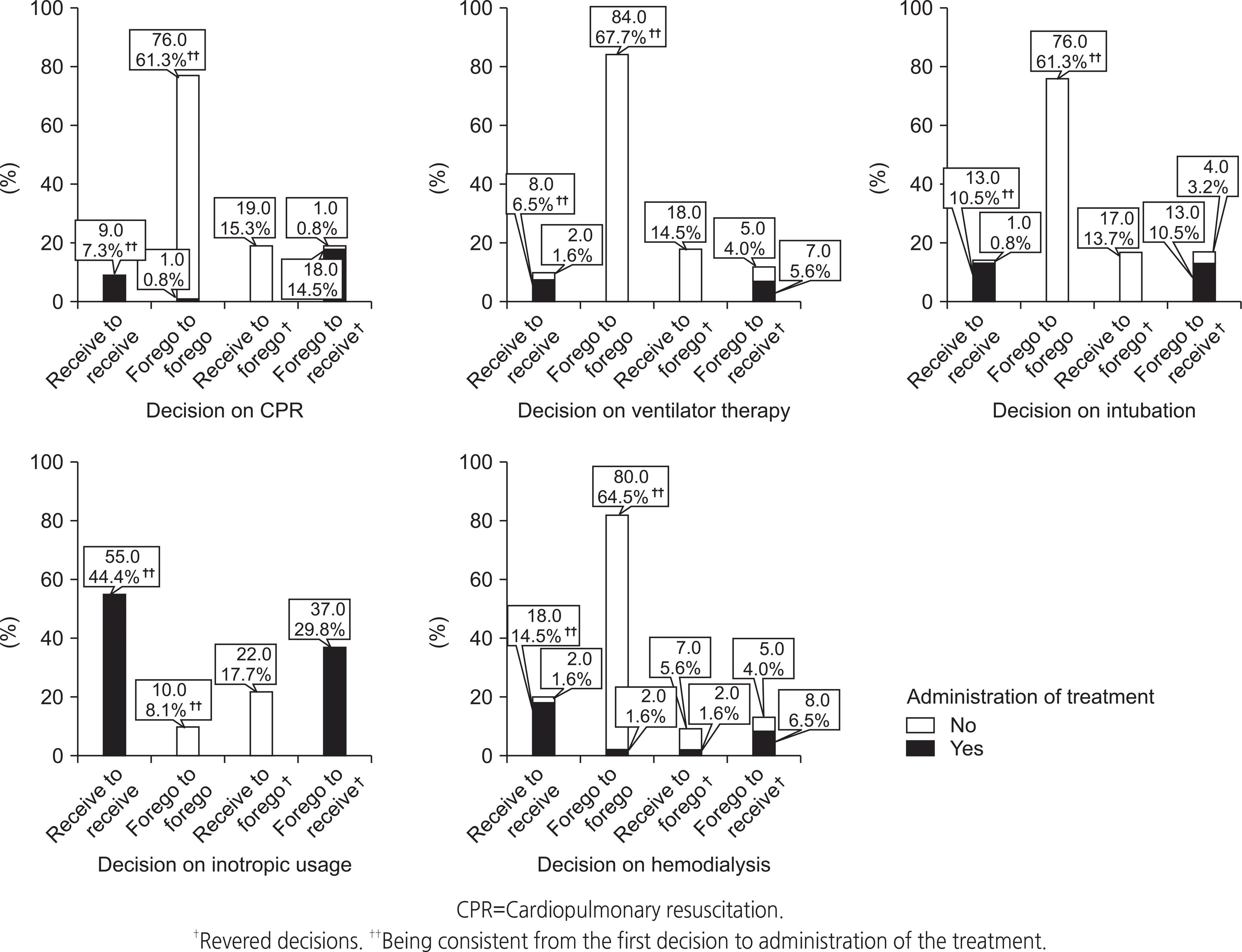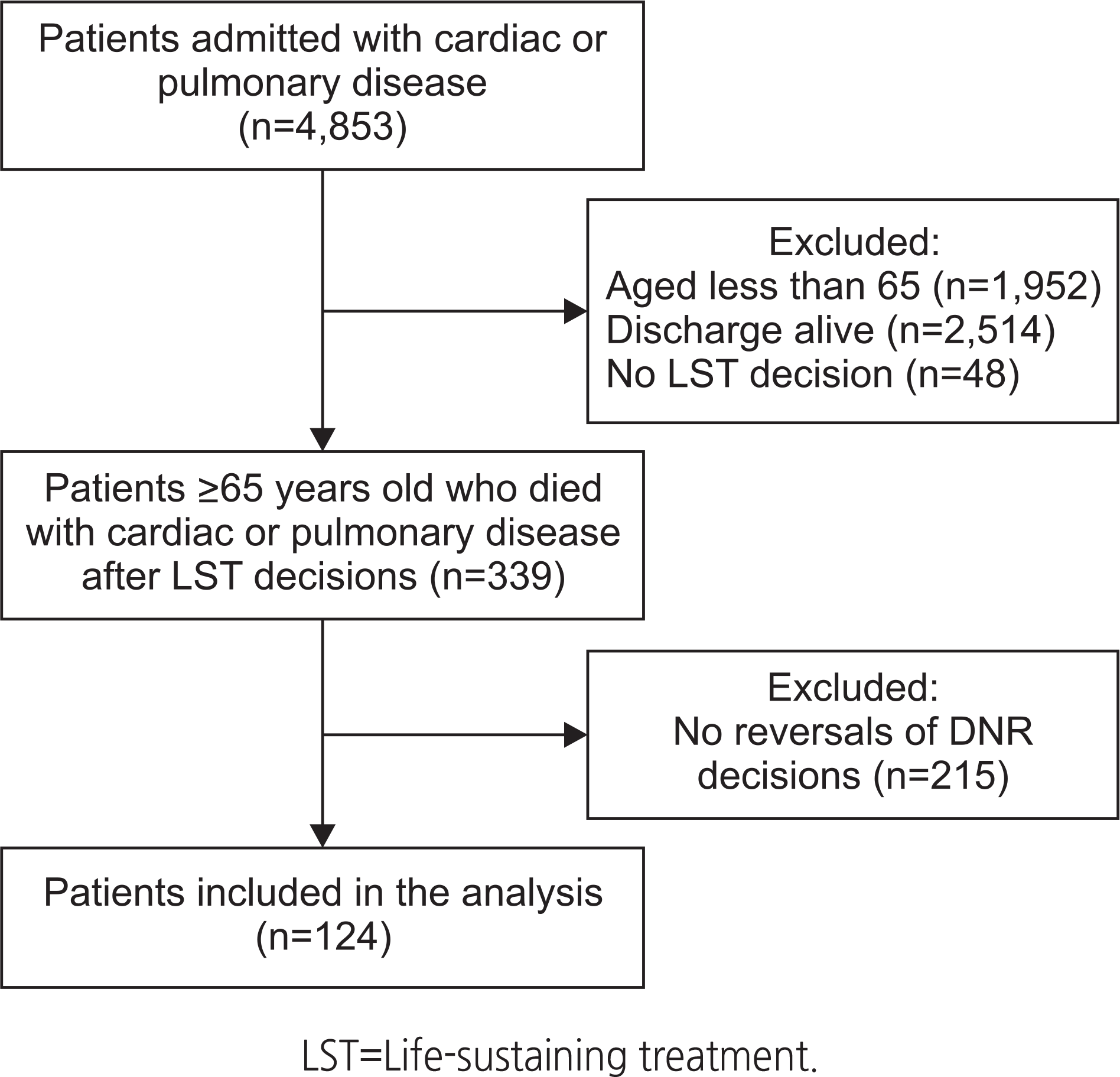Abstract
Purpose
The purpose of this study was to investigate the frequency, patterns, and factors of reversals in decisions about life-sustaining treatment (LST) among older patients with terminal-stage chronic cardiopulmonary disease.
Methods
This was a retrospective correlational descriptive study based on medical chart review. De-identified patient electronic medical record data were collected from 124 deceased older patients with terminal-stage cardiopulmonary disease who had made reversals of LST decisions in an academic tertiary hospital in 2015. Data were extracted about the reversed LST decisions, LST treatments applied before death, and patients’ demographic and clinical factors. Multivariate logistic regression analysis was used to identify the factors associated with the reversal to higher intensity of LST treatment.
Results
The use of inotropic agents was the most frequently reversed LST treatment, followed by cardiopulmonary resuscitation, intubation, ventilator therapy, and hemodialysis. Inconsistency between the last LST decisions and actual treatments occurred most often in hemodialysis. One-third of the reversals in LST decisions were made toward higher intensity of LST treatment. Patients who had lung diseases (vs. heart diseases); were single, divorced, or bereaved (vs. married); and had an acquaintance as a primary decision maker (vs. the patients themselves) were significantly more likely to reverse the LST decisions to higher intensity of LST treatment.
Go to : 
References
1. Chung KH, Oh YH, Lee YK, Oh MY, Kang EN, Kim KR, et al. Analysis of the 2017 survey of living conditions and welfare needs of Korean older persons. Sejong: Korea Institute for Health and Social Affairs;2017. Nov. Report No.: 11-1352000-000672-12.
2. Kim SH, Kang S, Song MK. Intensity of care at the end of life among older adults in Korea. Journal of Palliative Care. 2018; 33(1):47–52. https://doi.org/10.1177/0825859718754398.

3. Murray SA, Kendall M, Boyd K, Sheikh A. Illness trajectories and palliative care. British Medical Journal. 2005; 330(7498):1007–1011. https://doi.org/10.1136/bmj.330.7498.1007.

4. Ministry of Government Legislation. Act on hospice and palliative care and decisions on life-sustaining treatment for patients at the end of life [Internet]. Sejong: Ministry of Government Legislation;c2016. [cited 2018 Jan 2]. Available from:. http://www.law.go.kr/법령/호스피스ㆍ완화의료및임종과정에있는환자의연명의료결정에관한법률/(14013,20160203).
5. Kim DK. Hospice-palliative care and law. The Korean Journal of Medicine. 2017; 92(6):489–493. https://doi.org/10.3904/kjm.2017.92.6.489.

6. Auriemma CL, Nguyen CA, Bronheim R, Kent S, Nadiger S, Pardo D, et al. Stability of end-of-life preferences: A systematic review of the evidence. JAMA Internal Medicine. 2014; 174(7):1085–1092. https://doi.org/10.1001/jamainternmed.2014.1183.
7. Chavez G, Richman IB, Kaimal R, Bentley J, Yasukawa LA, Altman RB, et al. Reversals and limitations on high-intensity, life-sustaining treatments. PLoS One. 2018; 13(2):e0190569. https://doi.org/10.1371/journal.pone.0190569.

8. Song MK, Ward SE, Hanson LC, Metzger M, Kim SH. Determining consistency of surrogate decisions and end-of-life care received with patient goals-of-care preferences. Journal of Palliative Medicine. 2016; 19(6):610–616. https://doi.org/10.1089/jpm.2015.0349.

9. Pasman HRW, Kaspers PJ, Deeg DJH, Onwuteaka‐Philipsen BD. Preferences and actual treatment of older adults at the end of life: A mortality follow‐back study. Journal of the American Geriatrics Society. 2013; 61(10):1722–1729. https://doi.org/10.1111/jgs.12450.

10. Hart JL, Harhay MO, Gabler NB, Ratcliffe SJ, Quill CM, Halpern SD. Variability among US intensive care units in managing the care of patients admitted with preexisting limits on life-sustaining therapies. JAMA Internal Medicine. 2015; 175(6):1019–1026. https://doi.org/10.1001/jamainternmed.2015.0372.

11. Park SY. Current status of advance care planning and factors affecting in life-sustaining treatment decision-making process for critical ill patients in Korea [dissertation]. Ulsan: Ulsan University;2017. p. 1–136.
12. Allen LA, Yager JE, Funk MJ, Levy WC, Tulsky JA, Bowers MT, et al. Discordance between patient-predicted and model-predicted life expectancy among ambulatory patients with heart failure. JAMA. 2008; 299(21):2533–2542. https://doi.org/10.1001/jama.299.21.2533.

13. Kim SH. Family surrogates’ decision regret and psychological stress about end-of-life cancer treatments: Path analysis. Journal of Korean Academy of Nursing. 2018; 48(5):578–587. https://doi.org/10.4040/jkan.2018.48.5.578.

14. Faul F, Erdfelder E, Buchner A, Lang AG. Statistical power analyses using G*Power 3.1: Tests for correlation and regres- sion analyses. Behavior Research Methods. 2009; 41(4):1149–1160. https://doi.org/10.3758/BRM.41.4.1149.
15. Oken MM, Creech RH, Tormey DC, Horton J, Davis TE, Mc-Fadden ET, et al. Toxicity and response criteria of the Eastern Cooperative Oncology Group. American Journal of Clinical Oncology. 1982; 5(6):649–656. https://doi.org/10.1097/00000421-198212000-00014.

16. Bursac Z, Gauss CH, Williams DK, Hosmer DW. Purposeful selection of variables in logistic regression. Source Code for Biology and Medicine. 2008; 3:17. https://doi.org/10.1186/1751-0473-3-17.

17. Kim KS. Application of advance directives at a general hospital [master’s thesis]. Ulsan: Ulsan University;2009. p. 1–70.
18. Kang NY, Park JY. Clinical characteristics of oncologic patients with DNR decision at a tertiary hospital. The Korean Journal of Hospice and Palliative Care. 2016; 19(1):26–33. https://doi.org/10.14475/kjhpc.2016.19.1.26.

19. Brehaut JC, O’Connor AM, Wood TJ, Hack TF, Siminoff L, Gordon E, et al. Validation of a decision regret scale. Medical Decision Making. 2003; 23(4):281–292. https://doi.org/10.1177/0272989X03256005.

20. Lee KH, Jang HJ, Hong SB, Lim CM, Koh YS. Do-not-resuscitate order in patients, who were deceased in a medical intensive care unit of an university hospital in Korea. Korean Journal of Critical Care Medicine. 2008; 23(2):84–89. https://doi.org/10.4266/kjccm.2008.23.2.84.

21. Kim HA, Park JY. Changes in life-sustaining treatment in terminally ill cancer patients after signing a do-not-resuscitate order. The Korean Journal of Hospice and Palliative Care. 2017; 20(2):93–99. https://doi.org/10.14475/kjhpc.2017.20.2.93.

22. Kim M. Noh S, Ryu E, Shin S. Research trend analysis of do-not-resuscitate decision: Based on text network analysis. Asian Oncology Nursing. 2014; 14(4):254–264. https://doi.org/10.5388/aon.2014.14.4.254.
23. Jung S, Lee H, Lee S. Characteristics of end of life sustaining treatment and attitudes towards advance directives among geriatric patients. Journal of East-West Nursing Research. 2014; 20(2):103–111. https://doi.org/10.14370/jewnr.2014.20.2.103.

24. Park SY. Decisions on life-sustaining treatment at the end of life. The Korean Journal of Medicine. 2018; 93(2):75–79. https://doi.org/10.3904/kjm.2018.93.2.75.

25. Hawkins NM, Virani S, Ceconi C. Heart failure and chronic obstructive pulmonary disease: The challenges facing physicians and health services. European Heart Journal. 2013; 34(36):2795–2807. https://doi.org/10.1093/eurheartj/eht192.

26. Song TJ, Kim KP, Koh YS. Factors determining the establishment of DNR orders in oncologic patients at a university hospital in Korea. The Korean Journal of Medicine. 2008; 74(4):403–410.
Go to : 
 | Figure 2.Reversals of life-sustaining treatment decisions and administered treatment before death. Numbers show n and % of the decisions and administrations of the treatments. |
 | Figure 3.Reversal of code status and administered treatments. Numbers show n (%) of the decisions and administrations of the treatments; †Reversal to higher intensity of life-sustaining treatment. |
Table 1.
Characteristics of Participants and Comparisons between Reversals of Decisions to Higher and Reversals of Decisions to Equal or Lower Intensity of Life-Sustaining Treatment (N=124)
Table 2.
Multivariate Logistic Regression Analysis on the Factors Associated with Reversals of Decisions to Higher Intensity of Life-Sustaining Treatment




 PDF
PDF ePub
ePub Citation
Citation Print
Print



 XML Download
XML Download